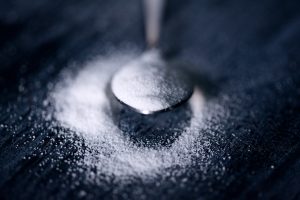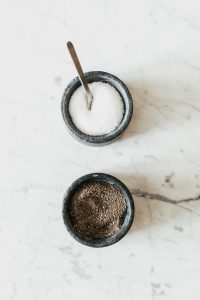
Most sweeteners on the market today are highly processed and refined, and they bear no resemblance to their natural counterparts, which are sugars found in nature.
Before natural sugars are refined and bleached into the white sugar found on tabletops and in processed foods, they are rich in vitamins and minerals; after processing, these processed sugars are void of nutrients.
Natural Sugars
Natural sweetness comes from the following sugars found in nature:
- Glucose – sometimes called blood sugar or dextrose
- Fructose – a simple sugar found naturally in fruits and honey
- Lactose – also known as milk sugar
- Maltose – the sugar found naturally in sprouted grain
- Sucrose – a mix of glucose and fructose
When consumed as a “processed” form, simple sugars are made from glucose, fructose, and sucrose and these sugars cause a rapid rise in blood sugar levels – a sugar high – followed by a drastic plunge – a sugar low.
Refined sugars – white and brown – are not nutritious substitutes for natural sweeteners. They are NOT the real thing, and should be avoided.

The Real Thing
Sucrose occurs naturally in most green plants, and is produced by photosynthesis, which is how the plant forms its own food using the sun’s energy.
You would have to stop eating fruits and vegetables (and all food products with natural, unadulterated sugars) to cut sugar completely out of your diet.
Here’s a common misconception: there is a difference between the way your body is signaled by the sugar in an apple and from refined sugar in the sugar bowl.
What do I mean?
To your body, all sugars are the same when they enter your body. Your body can’t tell where the sugar comes from. This is the danger of eating artificial, chemical sweeteners. The marketers say that “fake sugars” are not metabolized (digested) by your body.
Folks, this is false. Your body will try to metabolize ANY sugar-signal it receives no matter where it has come from!

Your body cannot discriminate and it can’t read labels.
Sugars Are Carbs Meant As Fuel
All sugars are carbohydrates.
Traditionally for most consumers, the word “sugar” means little white crystals that you stir into your coffee or tea, bake in your cookies, and sprinkle on your cereal.
These sugar crystals are known as sucrose.
In its raw form, sucrose is a disaccharide – two simple sugar molecules of glucose and fructose that occur naturally in fruits and vegetables and found in the greatest quantity in sugar cane and sugar beets. This is the sugar that is separated and processed for commercial use.
Monosaccharides are single sugar molecules (typically manufactured and refined forms of sucrose) that seep into your bloodstream and typically spike blood sugar.
Complex carbohydrates are the disaccharides, and are the “real sugars” that come from fruits, grains and vegetables. These are a healthier natural sugar because they have two molecules that make it bulky with texture so they don’t penetrate into the bloodstream.
These are better sugars for diabetics and for weight loss, and come from milk sugar and whole grain sugars. (For the negative-nellies out there, I am NOT saying to drink milk, use milk products, or load up on grains if that does not fit into your diet, I am just stating that milk and whole grains have natural sugars that your body can utilize for energy.)
White sugar usually comes from sugar cane or sugar beets that have undergone a rigorous refining process. White sugar is commonly a crystal, compressed into cubes, or pulverized to superfine confectioner’s sugar or powdered sugar.
Brown sugar is merely refined white sugar crystals with molasses added to give it the brown color.
Natural raw forms of sucrose are:
- beet sugar,
- maple sugar,
- raw sugar
After complex carbohydrates are broken down to simple sugars (most sugars and carbohydrates are eventually broken down to glucose), the sugars are absorbed into the bloodstream and go to the liver. There, they are stored as glycogen or used immediately as glucose for energy by the body or brain.
JUST A NOTE:
Glycogen is considered the principal storage form of glucose (energy), and is found mainly in your liver and in your muscles. Your kidneys and intestines are minor storage sites.
The body uses glucose as its simplest form of energy,” says Judith Wurtman, Ph.D., research scientist in the Department of Brain and Cognitive Sciences at the Massachusetts Institute of Technology (MIT). “So for people who need calories, that is, those who are recovering from an operation or who are shipwrecked, sugar can keep them alive.”
Thomas Jukes, Ph.D., professor of biophysics at the University of California at Berkeley, fed laboratory rats protein, vitamins, minerals, and sugar as the sole source of carbohydrates.
The rats thrived,” he said, “Fish is not a brain food. Glucose is.”
So, don’t fear natural sugars, and if diabetic, choose which forms you use selectively. And as I always say, moderation is the key.

_____________
If you want to learn more about healthy eating, contact me at janethull.com. Remember that you are never alone when you are looking for good health!
Gain access to all of my online programs, ongoing support, monthly Q&A, and more by joining my Private Inner Circle Membership Program. I look forward to supporting you on your journey to alternative health and wellness.
_____________
Disclaimer: This article is for informational purposes only, and is educational in nature. The FDA may not have evaluated some of the statements. This article is not intended to diagnose, treat, cure, or prevent any disease. Please discuss with your own, qualified health care provider before adding supplements or making any changes to your dietary program.
Before taking vitamins, consult your doctor; pre-existing medical conditions or medications you are taking can affect how your body responds to multivitamins.
You have our permission to reprint this article if you attribute us with a live back-link to this article and the youtube links. https://janethull.com/